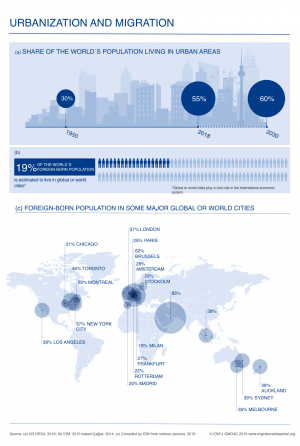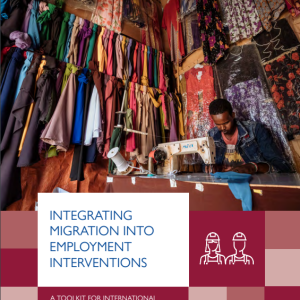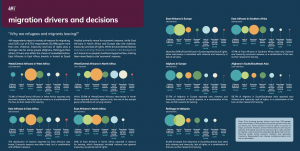Urbanization and migration
Migration, whether internal or international, has always been one of the forces driving the growth of urbanization and bringing opportunities and challenges to cities, migrants and governments. Increasingly, municipal authorities are becoming recognized as key actors in managing migration and have started including migration in their urban planning and implementation.
For cities to better manage migration, data on migration and urbanization are essential. However, these data are not always available or – if available – not used or accessible at the urban level, nor disaggregated, comprehensive or comparable, particularly in low-income countries.
Data could improve urban planning and delivery of public services, as well as help measure progress toward Sustainable Development Goals (SDGs) related to cities and migration, implement the Global Compacts on Migration and Refugees, which emphasize the role of cities as stakeholders in migration, and fulfill migration-related commitments in the UN Habitat’s New Urban Agenda.
Back to top
Definition
These key concepts and definitions are important to understanding urbanization and migration. The list below is not an exhaustive list:
Urban is problematic to define and no single globally accepted definition of what constitutes an urban settlement exists. What national statistical offices define as “urban” varies from country to country and often varies over time within countries. Some countries define urban based on a minimum population threshold and population density, while other countries use an administrative definition of what constitutes an urban area. Yet others, include more criteria such as proportion of workforce employed in non-agricultural sectors and availability of infrastructure or of education, health and other services (IOM, 2015 and UN, 2018). Most urban population thresholds fall between one and five thousand inhabitants (IOM, 2015).
Urbanization or “urban transition” refers to “a shift in a population from one that is dispersed across small rural settlements, in which agriculture is the dominant economic activity, towards one that is concentrated in larger and denser urban settlements characterized by a dominance of industrial and service activities” (UN, 2018).
Urbanization generally occurs as a result of one or more of the following processes:
- natural population growth;
- when more people move from rural to urban areas;
- when the boundaries of what is considered urban are extended: and/or
- from the creation of new urban centres.
“Very often, urbanization is primarily the result of migration” (IOM, 2015).
Urban population growth is often confused with urbanization but is a distinct concept. Urban growth can take place without any urbanization if urban and rural areas are both growing at the same rate. Urban growth is the increase in the absolute number of people living within defined urban areas. It is defined as “the increase in the proportion of the urban population over time as part of the whole population. Urban growth comes from demographic growth and international and internal migration (IOM, 2015).
Urban-to-urban migration, rural-to-rural migration, rural-to-urban migration, and urban-to-rural migration: These types of migration refer to the movement of people from one urban or rural area to a different urban or rural area. These types of migration may happen within a national border or involve crossing an international boundary (IOM Glossary, 2011).
City is also difficult to define because what constitutes an urban settlement varies and there are no standardized international criteria for determining the city (UN DESA, 2018). Multiple boundary definitions can exist for any given city. In general, there are three concepts:
- City proper describes a city according to an administrative boundary (ibid.).
- Urban agglomeration considers the extent of the contiguous urban area, or built-up area, to delineate the city’s boundaries and is therefore bigger than the city proper (ibid.).
- Metropolitan area defines its boundaries according to the degree of economic and social interconnectedness of nearby areas, identified by interlinked commerce or commuting patterns, for example. Metropolitan areas are bigger than the city proper, and can be as big as urban agglomeration, but distinct. While both urban agglomerations and metropolitans can be defined by size, density and contiguity, the definition of metropolitan areas includes other criteria such as administrative functions, and industries and services available, to name a few (ibid.).
Cities can also be categorized by population thresholds (IOM, 2015, based on UN DESA):
- Small cities have up to 1 million inhabitants
- Medium-sized cities are cities with 1 to 5 million inhabitants
- Large cities are cities with 5 to 10 million inhabitants
- Megacities are cities with 10 million or more inhabitants
Recent trends
Urbanization
A majority and growing proportion of the world’s population is living in urban areas. The share of the world’s population living in urban areas is expected to increase from 55 per cent in 2018 to 60 per cent in 2030 (UN, 2018). In 1950, 30 per cent of the global population was living in urban areas (ibid.).
In 2018, Northern America was the most urbanized region in the world, with 82 per cent of its population living in urban areas. This was followed by Latin America and the Caribbean (81%), Europe (74%) and Oceania (68%) (UN, 2018). The lowest levels of urbanization are found in Asia (50%) and Africa (43% ), however with large differences among some countries (ibid.).
Most of the world’s fastest growing cities are in Asia and Africa. Between 2018 and 2050, the urban population of Africa is projected to triple and that of Asia to increase by 61 per cent, so that by 2050 most of the world’s urban population will be concentrated in Asia (52%) and Africa (21%) (UN, 2018).
Urban population growth has been propelled by the growth of cities of all sizes. In 2018, 33 megacities hosted 13 per cent of the global urban population (UN, 2018). By 2030, the number of megacities is projected to increase to 41, with 14 per cent of urban dwellers worldwide residing in megacities (ibid.).
Urbanization and migration
Approximately one in five international migrants are estimated to live in just 20 cities -Beijing, Berlin, Brussels, Buenos Aires, Chicago, Hong Kong SAR, China, London, Los Angeles, Madrid, Moscow, New York, Paris, Seoul, Shanghai, Singapore, Sydney, Tokyo, Toronto, Vienna and Washington DC (IOM, 2015)1
. For 18 of these cities, international migrants represented around 20 per cent of the total population (ibid.).
The share of foreign-born persons in the total population in some cities exceeds the global average (around 3.5%) by a large margin (IOM, 2015). Dubai has an foreign born population of close to 83 per cent, while in Brussels it is 62 per cent, in Toronto 46 per cent, New York 37 per cent, and Melbourne 35 per cent, to name a few examples (ibid.).
Different types of migration play a role in urban growth and diversity, but to different extents. In the developed countries, one of the main sources of population diversity is international migration, while in the developing countries it is most likely internal migration (IOM, 2015), in addition to demographic growth through births outnumbering deaths.
In some countries, rural-to-urban migration and reclassification of what is considered urban together accounted for more than half of the urban growth, such as in China and Thailand (80%), Rwanda (79%), Indonesia (68%) and Namibia (59%) (UN, 2018). Circular and temporary migration is found in many urban parts of fast-urbanizing Asian and African countries, especially China and India as well as Ghana and Kenya (ibid.).
Data sources
Data sources on migration exist, as do data sources on urbanization. What is harder to find are reliable, comparable and comprehensive data sources that combine both migration and urbanization data.
The general lack of migration data (availability and accessibility) at the urban level, especially for low income countries, perhaps reflects (1) the long-standing focus on the nation as the unit of analysis in migration research and migration policy and (2) a general disjuncture between national and local policies on data collection for migration management purposes.
The key data sources that combine both migration and urbanization data are:
Censuses generally capture city-level data on the stock of international migrants every ten years or so; data collected are basic and aggregated. Censuses may undercount migrant numbers as they usually exclude data on irregular migrants and migrants living in peri-urban areas or the areas between the suburbs and the country side. Censuses also capture city-level data on internal migration by recording changes of residence of individuals over a given time.
Population registers also capture city-level data on internal migration and the stock of international migrants. Compared to censuses, the data captured through population registers are timelier, updated more frequently, and provide more demographic and socioeconomic information. Like censuses, population registers usually do not capture data on irregular migrants. Population registers are also found in relatively few countries—usually in the more developed parts of the world.
Surveys can capture city-level data on internal migration and international migration but provide more detailed data on migrants than censuses and population registers. Demographic and Health Surveys (DHSs), for example, can provide data on migrant health outcomes and nutrition-related information at the city level. DHSs can also provide data on rural-urban internal migration, and in a few cases, rural-urban international migration. Furthermore, labour market surveys can provide data on migrants’ socioeconomic outcomes, making them useful for measuring immigrant integration.
Compared to censuses and population registers, surveys better capture undercounted migrants, such as irregular migrants, and facilitate identifying groups of migrants, such as women, children, and refugees.
Administrative data sources, such as border statistics, residency permits, and naturalization records can capture city level data on internal and international migrants, but are not comprehensive, may not always be publicly available, do not capture irregular migrants, and may overcount migrants.
Globalization, Urbanization & Migration (GUM) website – Although there is no comprehensive, comparative global dataset on the relationship between cities and immigration, GUM’s global urban database is a first effort to create one. Based on country census data and UN urbanization data, the database includes urban-level data that measure immigration for more than 150 metropolitan areas (over 1 million inhabitants) in more than 50 countries). Data cover traditional immigrant gateway cities and emerging destinations.
These key data sources on urbanization are important for migration research:
- The World Urbanization Prospects—UN DESA’s has been issuing since 1988 annually updated estimates and projections of the urban and rural populations for all countries of the world, and of their major urban agglomerations.
- The UN Statistics Division’s Demographic Yearbook data collection system compiles and disseminates data from national statistical offices on population density and urbanization. Several tables, presented in the yearbook, provide disaggregated statistics by urban and rural breakdown. Data on population of capital cities and cities of 100,000 and more inhabitants are also available. The UN Population Division uses these data for estimates presented in World Urbanization Prospects.
- The United Nations Human Settlements Programme (UN-Habitat) collects, compiles, analyses and reports data on national, urban/rural and city level in order to monitor human settlement conditions and trends. UN-Habitat’s key publications include the Compendium of Human Settlement Statistics, the Global Reports on Human Settlements, and the State of the World’s Cities Reports series.
The Global Urban Observatory (GUO) at UN Habitat is a specialized statistical unit, that supports data collection and analysis for urban indicators. GUO also maintains the Global Urban Indicator database, and supports the monitoring and reporting of the New Urban Agenda and SDG 11, which seeks to “make cities and human settlement inclusive, safe, resilient and sustainable.“
Data strengths & limitations
Data on urbanization and migration show that migration is driving —and will continue to drive – the growth and diversity of cities. However, certain limitations in migration data and data linking migration and urbanization prevent researchers and policy makers from fully understanding the impact of migration on cities and how moving to a city affects migrants. Such data—as well as the political will to use data when available—are needed for effective urban planning, better socio-economic policies and services that facilitate migrant integration, policy coherence, and informed coordination across different levels of governments and other stakeholders.
Various limitations on using censuses, surveys, populations registers, and administrative sources for research on migration and urbanization are covered in IOM’s World Migration Report 2015. Further limitations on migration data are covered on the migration data sources page and other thematic pages.
Key limitations specific to data linking migration and urbanization include:
Lack of standard definitions – What is considered urban or a city varies from country to country and sometimes it varies over time within countries, making comparative analysis difficult. There is also no standard definition for who is considered a migrant. Some countries define "migrant" by country of birth; others by nationality.
There is also no single global standard definition for internal migration, which in some countries drives urbanization more than international migration.
Lack of foreign-born data at the urban level – Even if definitions were standardized, most countries only collect and aggregate foreign-born data at the national or state level and not at an urban level. This is true especially of foreign-born urban populations in most low-income countries. Such data could allow city governments to not only meet, but also better anticipate the migrants’ housing, health care, and educational needs, for example.
Lack of data disaggregated by age and sex – If foreign-born data exist at the urban level, they are not always disaggregated by factors such as age, sex, or disability. Such data could provide local governments with information to estimate the needs and gaps in services for particular groups of migrants such as children, youth, older persons, and disabled migrants.
Further reading
Duncan, H. and Popp I.
2018 World Migration Report 2018, Chapter 10: Migrants and Cities: Stepping Beyond World Migration Report 2015, IOM, Geneva.
United Nations
2018 Sustainable cities, human mobility and international migration: Report of the Secretary-General, UN, New York.
2017 New Urban Agenda, Habitat III Secretariat, Nairobi.
International Organization for Migration (IOM)
2016 Conference on Migrants and Cities, IOM, Geneva.
2015 World Migration Report 2015: Migrants and Cities: New Partnerships to Manage Mobility, IOM, Geneva.
World Economic Forum (WEF) in collaboration with PwC
2017 Migration and Its Impact on Cities, WEF, Geneva.
Charles, A., Galal H., and Guna D.
2018 Preparing Cities to Manage Migration, A policy brief from the Think20 Migration Task Force, CARI and CIPPEC, Buenos Aires.
Jansen, K. et al.
2018 Economic Migration and the Role of Cities – Ensuring Social Cohesion, A policy brief from the Think20 Migration Task Force, CARI and CIPPEC, Buenos Aires.
United Nations Department of Economic and Social Affairs (UN DESA)
2018 World Urbanization Prospects: The 2018 Revision, UN DESA, Population Division.
2018 The World’s Cities in 2018—Data Booklet, UN DESA, Population Division.
2013 Cross-national comparisons of internal migration: An update on global patterns and trends. UN DESA, Population Division.
Singer, Ay.
2015 “Metropolitan Immigrant gateways revisited,2014” Brookings Institution.
George Washington University, Columbian College of Arts and Sciences
Globalization, Urbanization & Migration (GUM) website - provides empirical data at the urban-level to measure immigration in cities around the world.
- 1Most of the international migrants in Hong Kong SAR, China are from neighboring parts of China.







